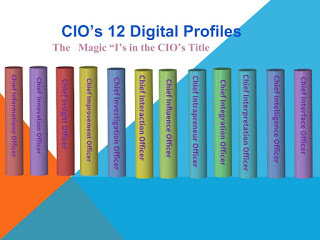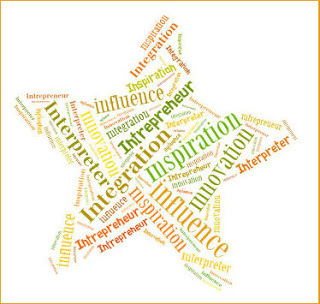“CIO Master” Book Preview: Chapter 1 “Twelve Digital CIO Personas” Introduction
 Nowadays, information is lifeblood, and technology is the disruptive force in any business and any industry. Hence, CIOs as IT leaders also a play a more critical role in business strategy making & execution, driving business changes and innovation. Compared to other CxOx, the CIO role is considerably new with less than three decades of history, but more dynamic and paradoxical. The IT leadership role also continues to be reimagined, refined, refreshed, and reenergized. The CIO is no longer just a glorified geek, but a business savvy strategist and transformational leader. Modern CIOs have multiple personas and need to wear many hats to communicate effectively and lead more successfully. In chapter 1 of “CIO Master - Unleash the Digital Potential of IT,” we describe CIOs’ 12 Digital profiles. Here we list five featured CIO personas:
Nowadays, information is lifeblood, and technology is the disruptive force in any business and any industry. Hence, CIOs as IT leaders also a play a more critical role in business strategy making & execution, driving business changes and innovation. Compared to other CxOx, the CIO role is considerably new with less than three decades of history, but more dynamic and paradoxical. The IT leadership role also continues to be reimagined, refined, refreshed, and reenergized. The CIO is no longer just a glorified geek, but a business savvy strategist and transformational leader. Modern CIOs have multiple personas and need to wear many hats to communicate effectively and lead more successfully. In chapter 1 of “CIO Master - Unleash the Digital Potential of IT,” we describe CIOs’ 12 Digital profiles. Here we list five featured CIO personas:
CIO as “Chief Information Officer”: Back to fundamental, IT is the information steward of the organization, and the magic “I” in CIO title implies “INFORMATION” - one of the invaluable assets in businesses today. And one of the critical responsibility for IT is to ensure the right people getting the right information at the right time to make right decisions. Because today IT is permeating into every corner of the organization, and all forward-thinking organizations across industrial sectors declare they are into the information management business. IT indeed needs to shift from “T” driven operation to “I” focused - Information, Intelligence, and Insight. And the CIO role needs to focus on both information content and context, how that information can be tapped from the underlying data and be utilized to turn it into valuable business insight and foresight. As CIOs continue to be put on the front line to run IT as a digital transformer, they need to ensure their organizations are information savvy, high-intelligent and high-effective.
CIO as “Chief Innovation Officer”: IT is shifting from a back office function to a digital brain yard; from a support desk to an innovation engine. IT leaders are often in the right position to oversee business processes, identify critical business issues by working closely with business partners from a long-term perspective, and leverage technology to manage innovation across the enterprise boundary. So the challenge for CIOs is how to strike the right balance of innovation and stabilities; flexibility and standardization; long-term perspective and short term quick win. IT leaders also need to manage a balanced innovation portfolio, including both incremental innovation and disruptive innovation, in a systematic way. It also means to build a culture of innovation to tolerate failure and inspire creativity. Opening up a spirit and opportunity for people to stretch and try new things will generate more returns than was ever thought possible.
3. CIO as “Chief Influence Officer”: Digital CIO is a transformational leadership role, not just a transactional manager. Hence, CIOs need to continually practice leadership influence. At the dawn of digitalization, organizations large and small are experiencing social computing, the CIO usually takes the lead role in orchestrating enterprise’s social strategy, sets up the social platforms and tools and governs & monitors their performance. A CIO also must ensure understanding of the business need, a CIO needs to make sure she/he is able to translate the technical needs into the business language. It is also important to add social collaboration theme in IT management. “Eat your own cookie” is part of a CIO’s strategy to give everybody in the organization the user experience. IT leaders can leverage many emerging digital technology trends to amplify leadership influence and scale up innovation practices.
4. CIO as “Chief Intrapreneur Officer”: “Running IT as a software startup” becomes a mantra for many innovative IT organizations. Intrapreneur executive leadership is an emergent trend. It is the mindset and act of behaving like an entrepreneur while working within a large, well-established organization. Often, the CIOs who have come up from a technical ladder are good at bottom line efficiency, but an intrapreneur mindset will help CIOs become more innovative and aggressive, management both opportunities and risks accordingly. It takes courage to be an intrapreneur, as well as a CIO, because it’s not an easy job to face and manage risks and ambiguity, and overcome barriers every day. Many intrapreneurs taste risk as bitter experience and show resilience to recover. Such mental toughness will help any organization to be more resilient and nurture the culture of risk-tolerance and intelligence.

5. CIO as “Chief Interpretation Officer”: Digital IT organizations are not longer the sum of silo functions, but an integral whole. IT leaders are in the unique position to oversight organizational underlying processes, and IT is a key business enabler. Hence. It takes vision-based communication for the CIO to deliver a convincing alternative view of IT being a profit center and value enhancer. The CIO needs to play as a “Chief Interpretation Officer” to convey the vision, to bridge the gaps and to enforce the need for multi-layer, multi-dimensional communication. The CIO needs to be an enterprise “polyglot,’ to master both business language and IT terminology, architectural dialects and culture tones, regional viewpoints and global perspective. A good communication takes empathy as well, the CIO is in the unique position to not only ensure he/she communicates with empathy but also to streamline the organization’s digital communication channel and delivery. And CIOs need to interpret business insight and play different roles effortlessly as a change agent, a strategist, a talent master and a tactical IT manager.
Digital CIOs are born to change, regardless which role they should play in which circumstances, they have to overcome digital transformation challenges depending on their ability to think, adapt, proactively plan and execute. To sum up, the CIO should stand for “Chief Inspirational Officer,” to inspire others to reach business vision and achieve a high-performance result. Follow us at: @Pearl_Zhu
Published on March 27, 2016 22:51
No comments have been added yet.



